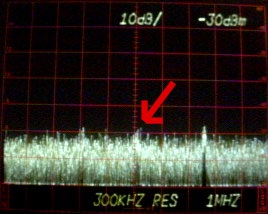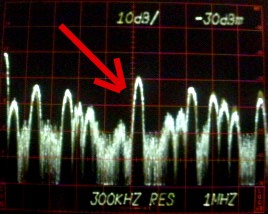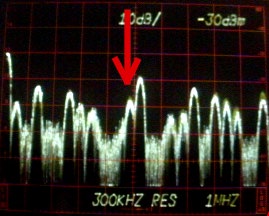



AID - Westinghouse/Audio Intelligence Devices, Inc. Bug Frequency 135 MHz - 150 MHz Special Order/Secondary Band (also 138-162 MHz) 150 MHz - 174 MHz Standard/Primary Band (Most Popular Band) 216 MHz - 220 MHz Special Order 400 MHz - 470 MHz UHF Repeaters 806 MHz - 821 MHz Digital Spread Spectrum TX-8xx (BPSK-407kb Direct Sequence) 851 MHz - 869 MHz Body Pack/Wire (NFM) TX-11xx 902 MHz - 928 MHz Digital Spread Spectrum TX-8xx (BPSK-407kb Direct Sequence) 21 MHz - 80 MHz Very Low Power WFM (.5mw - 10mw) Special Order Only 36 MHz - 39 MHz Very Low Power WFM (.5mw - 50mw) ***Very Dangerous*** 80 kHz - 200 kHz "Line Carrier" Microphone Systems ***Very Dangerous*** 30 kHz - 700 kHz Spread Spectrum Current Carrier Devices 1700 MHz - 1900 MHz 25-250mw Video and audio bugs (Mostly Federal Video Bugs) 2400 MHz - 2484 MHz 25-250mw Video and audio bugs (2.450 to 2.483 very popular) If the signal is "scrambled" it is nothing more than simple voice inversion, a circuit to "de-scramble" can be built for around $15. Note: AID devices are often re-tuned for out band channels... so be careful. The area of spectrum from 15 MHz to 500 MHz is the primary threat, 500 MHz to 2.7 GHz is the secondary threat, a "line carrier" threat is from 30 kHz to 750 kHz. If the person planting the bug suspects that a TSCM inspection may be conducted then AID suggests a frequency between 30 MHz to 50 MHz, sensitivity of receiver should be better than .18uv/-122dbm. The mode/modulation is recommended by AID to be wideband FM. Also, keep in mind that AID devices are frequently used for illegal buggings, so be familiar with what their realistic specs are, expect power outputs well under 50mw, and expect to see the AC power circuits being used as the antenna.

Security Research Bugs - England 145 MHz - 175 MHz FAST-II-L Computer Bug - 1, 3, 10, 30, 100mw 170 MHz - 204 MHz FAST-II-H Computer Bug - 1, 3, 10, 30, 100mw 60 kHz - 200 kHz "Line Carrier" Microphone Systems ***Very Dangerous*** 1.1 GHz - 1.4 GHz 250mw Lynx Video/Audio Bugs (L-Band) 2.5 GHz - 2.6 GHz 250mw Lynx Video/Audio Bugs 3.8 GHz - 4.2 GHz 250mw Lynx Video/Audio Bugs Note1: LYNX video bugs and cameras are frequently built into old bricks, wooden joists, logs, gate posts and such... VERY, VERY Dangerous and easily concealed. Note2: Most Security Research Bugs utilize fixed frequency inversion to protect against detection, a commonly used frequency is a 1.862 kHz inversion point.
HDS - Household Data Services 50.000 - 750.000 kHz Carrier Current Audio System 120.000 - 400.000 kHz Carrier Current Audio System 138.000 - 174.000 MHz Wireless microphone/Body Wires (8KR Series .1 to 30 mW) 150.000 - 174.000 MHz Wireless microphone/Body Wires (ATX Series .1 to 30 mW) 174.000 - 230.000 MHz Wireless microphone/Body Wires 350.000 - 440.000 MHz Audio/Video Transmitters (360-440 popular) 470.000 - 608.000 MHz Audio/Video Transmitters 570.000 - 928.000 MHz Audio/Video Transmitters (Spread Spectrum Popular) 1,000 - 1,500 MHz Low Power Audio/Video Transmitter (10-100mw max.) 1,425 - 1,450 MHz Low Power Audio/Video Transmitter (10-100mw max.) 1,700 - 2,700 MHz Audio/Video Transmitters 2.4-2.5 hot (10-100mw max.) 1,710 - 1,900 MHz Audio/Video Transmitters (10-100mw max.) ** HOT ** 6,425 - 7,125 MHz Low Power Audio/Video Transmitter (10-100mw max.) 8,100 - 8,700 MHz Audio/Video Transmitter, 8.2/8.5 popular (10-100mw max.) 10,200 - 10,700 MHz Audio/Video Transmitter, 10.5 popular (10-100mw max.) 17,700 - 19,700 MHz Low Power Audio/Video Transmitter (10-100mw max.) 20,000 - 24,600 MHz Low Power Audio/Video Transmitter (10-100mw max.)
Sony - Wireless Microphones and Body Wires 470.000 - 489.000 MHz 2.5mw - 20mw, WFM (110 kHz), Ultra low power 770.000 - 782.000 MHz 2.5mw - 10mw, Ultra low power - TV Channel 64 782.000 - 794.000 MHz 2.5mw - 10mw, Ultra low power - TV Channel 66 794.000 - 806.000 MHz 2.5mw - 10mw, Ultra low power - TV Channel 68 770.000 - 810.000 MHz 2.5mw - 20mw, WFM (110 kHz), Ultra low power 902.000 - 928.000 MHz 2.5mw - 20mw, WFM (110 kHz), Ultra low power 947.000 - 954.000 MHz 2.5mw - 20mw, WFM (110 kHz), Ultra low power 60.000 - 970.000 MHz 2.5mw - 10mw, WFM (300 kHz) Audio Transmitter
Lorraine Electronics Surveillance 365.000 - 455.000 MHz Low Power NF Audio Transmitter (9 specific channels)
SKS - Skaggs Telecommunications Service 170.000 - 216.000 MHz Low Power Audio Transmitter/Body Wire
Swintek 136.000 - 150.000 MHz Wireless microphone/Body Wires (Special Order) 150.000 - 174.000 MHz Wireless microphone/Body Wires (Standard) 170.000 - 220.000 MHz Wireless microphone/Body Wires (Special Order) 200.000 - 470.000 MHz Wireless microphone/Body Wires (Special Order)
Broadcast Microwave Services 1.990 - 2.5000 GHz S-band Video Transmitters (under 100mw) 6.400 - 7.2000 GHz Video Transmitters (under 5mw) 6.785 - 7.1250 GHz Video Transmitters (under 10mw) 1.400 - 8.5000 GHz Video Transmitters (under 10mw) 12.700 - 13.2500 GHz Video Transmitters (under 10mw) 1.000 - 13.0000 GHz Video Transmitters (under 5mw)


Xandi Electronics
143.500 - Low Power Kit Bug (130 - 160 w/mod) Part 15 device
88.000 - 108.000 MHz Low Power Kit Bug (70 - 120 w/mod) Part 15 device
DECO
398.600 - Low Power Kit Bugs - Part 15 device
399.450 - Low Power Kit Bugs - Part 15 device
399.030 - Low Power Kit Bugs - Part 15 device
406.000 - Low Power Kit Bugs - Part 15 device
365.000 - 420.000 MHz Low Power Kit Bugs
Sheffield Electronics - No longer made
70.000 - 119.000 MHz Surveillance Transmitter Kits (under .1 - 10mw)
145.000 - 180.000 MHz Surveillance Transmitter Kits (under .1 - 10mw)
160.000 - 240.000 MHz Surveillance Transmitter Kits (under .1 - 10mw)
235.000 - 305.000 MHz Surveillance Transmitter Kits (under .1 - 10mw)
Vega
150.000 - 216.000 MHz Wireless microphone/Body Wires (Dynex, VX, T, etc...)
169.000 - 216.000 MHz Wireless microphone/Body Wires (Dynex, VX, T, etc...)
HM Electronics
160.000 - 174.000 MHz Wireless microphone/Body Wires (Sys 50/55, below 50mw)
174.000 - 216.000 MHz Wireless microphone/Body Wires (Sys 50/55, below 50mw)
Sennheiser
165.000 - 216.000 MHz Wireless microphone/Body Wires (SK Series)
770.000 - 810.000 MHz Wireless microphone/Body Wires
Telex
62.100 - 85.400 MHz Soundmate Products (Commonly Modified)
135.000 - 150.000 MHz Wireless microphone/Body Wires (WT Series) * HOT *
150.000 - 165.000 MHz Wireless microphone/Body Wires (WT Series) * HOT *
165.000 - 185.000 MHz Wireless microphone/Body Wires (WT Series) * HOT *
185.000 - 205.000 MHz Wireless microphone/Body Wires (WT Series)
165.000 - 210.000 MHz Wireless microphone/Body Wires (B/H/WT/G Series 30-50mw)
169.000 - 235.000 MHz Wireless microphone/Body Wires (FMR/HT/WT Series 35-50mw)
205.000 - 220.000 MHz Wireless microphone/Body Wires (WT Series)
450.000 - 470.000 MHz Wireless microphone/Body Wires (WT-450, below 50mw)
524.000 - 608.000 MHz Micropak Transmitter/Body Wires (35-50mw nominal)
518.000 - 760.000 MHz Micropak Transmitter/Body Wires (566-675 MHz popular)
614.000 - 746.000 MHz Micropak Transmitter/Body Wires (35-50mw nominal)
450.000 - 820.000 MHz Micropak Transmitter/Body Wires (15-35mw nominal)
Sampson
135.000 - 220.000 MHz Wireless microphone/Body Wires (Poor Quality Products)
Electrosonics, Inc.
150.000 - 216.000 MHz Wireless microphone/Body Wires
RF Link Technology Inc.
2.453 GHz WaveCom Wireless Video System - Channel A
2.473 GHz WaveCom Wireless Video System - Channel B
60-72 MHz Video/RF Output from 2.4 GHz Module
The WaveCom Video systems are commonly modified, repackaged,
and sold by "spy shops" and private investigators as an
eavesdropping device. The signature of such a device is
operation between 2.10 GHz and 2.85 GHz with a slightly
modified negative sync pulse on the video signal.
ITS Corporation
54 - 88 MHz Low Power Video Transmitter (5M75C3F/250KF3E)
174 - 216 MHz Low Power Video Transmitter (5M75C3F/250KF3E)
470 - 860 MHz Video System Transmitter (5M75C3F/250F3)
2.150 - 2.686 GHz Transmitter/Amp for WaveCom Video (5M75C3F/250KF3E)
2.150 - 2.700 GHz Transmitter/Amp for WaveCom Video (6M00B9F)
Lectrosonics, Inc.
135.000 - 174.000 MHz Wireless microphone/Body Wires (50mw max.)
174.000 - 216.000 MHz Wireless microphone/Body Wires (50mw max.)
470.000 - 608.000 MHz Wireless microphone/Body Wires (70mw max.)
Nady Systems
135.000 - 220.000 MHz Wireless microphone/Body Wires (VR series)
170.000 - 218.000 MHz Wireless microphone/Body Wires (VR series)
945.000 - 955.000 MHz Wireless microphone/Body Wires (VR series)
Electro Voice
135.000 - 220.000 MHz Wireless microphone/Body Wires (GS/MS Series)
169.000 - 216.000 MHz Wireless microphone/Body Wires (MB Series)
Shure Brothers
135.000 - 173.000 MHz Wireless microphone/Body Wires (171.845 popular)
160.000 - 216.000 MHz Wireless microphone/Body Wires (171.845 popular)
173.000 - 216.000 MHz Wireless microphone/Body Wires (below 25mw)
173.000 - 220.000 MHz Wireless microphone/Body Wires (L2 Series below 50mw)
Microwave Radio Corporation
1,700 - 2,700 MHz Low Power (3w - 42 Channels) Audio/Video Transmitter
6,425 - 7,125 MHz Low Power (1.5w - 30 Channels) Audio/Video Transmitter
17,700 - 19,700 MHz Video Transmitter - Broadcast Quality
21,200 - 23,600 MHz Video Transmitter - Broadcast Quality
Phonak - Switzerland
130.000 - 240.000 MHz MicroEar - In the ear FM-NB receiver system
138.000 - 190.000 MHz MicroEar - In the ear FM-NB receiver system
190.000 - 220.000 MHz MicroEar - In the ear FM-NB receiver system
Electra Enterprises
434.000 - 435.000 MHz Video Transmitter (40-80mw nominal)
900.000 - 915.000 MHz Video Transmitter (40-80mw nominal)
(Also, Television Channels 32,46,47,48,49 59, and 900 MHz)
DGR Engineering - France
85 kHz - 11.000 MHz Spread Spectrum Audio/ Low bandwidth Video
Cameras and Microphones are hidden inside functional electrical outlets.
System supports up to 240 cameras or microphones on same circuit.
Video and audio signals conducted over power lines. Commonly used for large
scale buggings, such as hotel rooms, dormitories, and large office
buildings. Such a system has been in operation at NATO Headquarters (NY)
for several years.
Recoton
912.000 - 915.000 MHz Popular Audio/Video Transmitters (914 MHz popular)
915.000 - 920.000 MHz Popular Audio/Video Transmitters (ultra low power)
902.000 - 928.000 MHz Popular Audio/Video Transmitters (ultra low power)
X10/BSR
290.000 - 305.000 MHz Transmits RF over AC power lines - Audio (301-303 hot)
301.000 - 315.500 MHz Transmits RF over AC power lines - Audio (310/312 hot)
410.000 - 426.000 MHz Transmits RF over AC power lines - Audio (418 hot)
Good Mind Industries - Taiwan
46.000 - 72.500 MHz Ultra Low Power Video/Audio Transmitter
Phonex
2.000 - 7.500 MHz Modified AC Mains Transmitter (-40 dBmv at 50 ohms)
2.620 - 6.400 MHz AC Mains Transmitter
5.500 - 7.000 MHz Wireless Phone Extender System (Sold at Radio Shack)
Radio Shack
24.00 - 180.00 kHz FM Wireless Intercom Systems (uses AC mains) - Older Units
120.00 - 200.00 kHz FM Wireless Intercom Systems (uses AC mains) - Older Units
200.00 - 270.00 kHz FM Wireless Intercom Systems (uses AC mains)
300.00 - 400.00 kHz FM Wireless Intercom Systems (uses Phone wires, 355 popular)
35.00 - 50.00 MHz FM Microphones (49.830, 49.855, 49.890, 37.600 Popular)
75.00 - 110.00 MHz Tie-Tack Microphones (FM Broadcast Band)
50.00 - 290.00 MHz FM Microphones (CM-421, below 5-50mw)
160.00 - 230.00 MHz FM Microphones (169-176 popular, 5-50mw max, 15mw typical)
700-950nm Infrared Audio Transmitter (150 kHz carrier typical)
Various
1.500 - 9.000 MHz Phone Extender Systems
15.000 - 75.000 MHz Micro-Wire Conducted RF Systems (under 10mw)
LOJACK Corporation
173.075 - LOJACK Auto tracking system beacon (200ms burst every second)
(This is the tracking device remotely activated via FM Sub Carrier)
Police Speed Enforcement Radar
10.450 - 10.600 GHz X-Band
11.488 - 11.628 GHz RD Detector
22.976 - 23.256 GHz RD Detector-2nd Harmonic
24.050 - 24.250 GHz K-Band
33.400 - 36.000 GHz Ka-Band
700nm - 1100nm Laser Threat
Electronic Article Surveillance and Anti-Shoplifting Systems
8.10 MHz - 9.30 MHz Checkpoint (Hi-Q Tags) 8.2 MHz Common
57.75 kHz - 58.75 kHz Sensormatic (Magnetic) Books, CD's, and Tapes
915 MHz and 1830 MHz Knogo (Microwave Resonant) Adhesive Labels
Metal Detectors
5 kHz - 210 kHz Walk Through and Handheld Units (i.e. Garrett)
WARNING:
The area between 600 MHz and 9 GHz is EXTREMELY DANGEROUS as the
eavesdropping equipment in that range is inexpensive, very low power,
and highly directional.
Additionally, most TSCM people tend not to check frequencies above 1 GHz or 3 GHz (because the equipment is an order of magnitude too expensive for them to buy).
![]() Common Eavesdropping Frequencies used by Amateur Eavesdroppers
Common Eavesdropping Frequencies used by Amateur Eavesdroppers
![]() Professional and Law Enforcement Bugging Frequencies
Professional and Law Enforcement Bugging Frequencies
![]() Surveillance Device "House" Frequencies/Bands
Surveillance Device "House" Frequencies/Bands
![]() Federal Surveillance Frequencies
Federal Surveillance Frequencies
![]() Surveillance and Spy Satellite Frequencies
Surveillance and Spy Satellite Frequencies
![]() Spread Spectrum and Frequency Hopping Bug Frequencies
Spread Spectrum and Frequency Hopping Bug Frequencies
![]() Bandwidth Resolutions and Filters
Bandwidth Resolutions and Filters
|
To be contacted for a confidential consultation please E-mail: jmatk@tscm.com
or send a letter via US Mail to:
or call: URL: http://www.tscm.com/ |